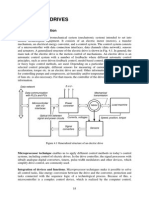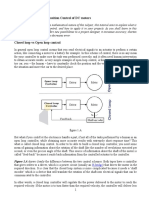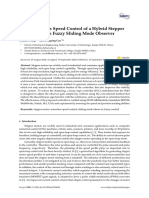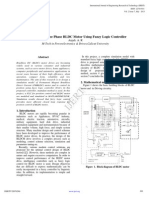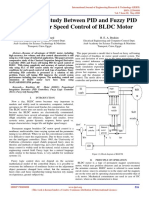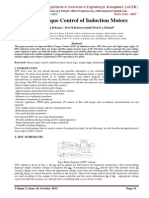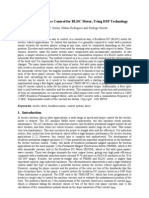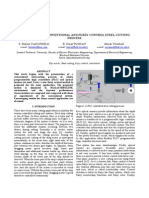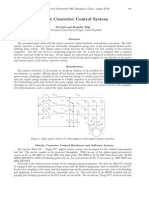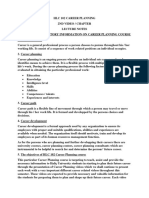Simulation of Speed Control of Brushless DC Motor, With Fuzzy Logic Controller
Simulation of Speed Control of Brushless DC Motor, With Fuzzy Logic Controller
Uploaded by
PradeepAgrahariCopyright:
Available Formats
Simulation of Speed Control of Brushless DC Motor, With Fuzzy Logic Controller
Simulation of Speed Control of Brushless DC Motor, With Fuzzy Logic Controller
Uploaded by
PradeepAgrahariOriginal Description:
Original Title
Copyright
Available Formats
Share this document
Did you find this document useful?
Is this content inappropriate?
Copyright:
Available Formats
Simulation of Speed Control of Brushless DC Motor, With Fuzzy Logic Controller
Simulation of Speed Control of Brushless DC Motor, With Fuzzy Logic Controller
Uploaded by
PradeepAgrahariCopyright:
Available Formats
International Journal of Electrical, Electronics and Data Communication, ISSN: 2320-2084
Volume-2, Issue-4, April-2014
SIMULATION OF SPEED CONTROL OF BRUSHLESS DC MOTOR,
WITH FUZZY LOGIC CONTROLLER
1
C. SHEEBA JOICE, 2P.NIVEDHITHA
1,2
Department of Electronics and Communication Engineering, Saveetha Engineering College, Chennai, India
Email: sheebajoice@saveetha.ac.in, nivedhitha.sembian@gmail.com
Abstract The electronically commuted Brushless DC motors are widely used in many industrial applications which
increase the need for design of efficient control strategy for these noiseless motors. This paper deals with the efficient speed
control mechanisms for these drives using meaningful fuzzy sets and rules. The fuzzy logic controller is developed using a
MATLAB/ Simulink tool. The paper deals with the possibility of designing a control strategy, to achieve accurate speed
control with the advantages of low cost. The proposed method is simple and efficient compared with the conventional
controllers.
Keywords BLDC motor drive, Fuzzy Logic Controllers, Fuzzy sets and Fuzzy rules, Speed control.
I.
The rotor position is sensed which enables
commutation logic for the three phase inverter circuits
that contain MOSFET switches.
INTRODUCTION
A. BLDC Motor with Hall Sensors
Brushless DC motors works similar to the
conventional DC motor with the mechanical
commutation replaced by an electronically controlled
commutation system. These motors have the rotating
permanent magnets and stationary armature. The
BLDC motor that are utilized in the proposed control
design is star connected BLDC motor. The power
distribution is achieved by the intelligent electronic
controller. The electronic controller requires rotor
position information for proper commutation of
currents in the respective stator windings. The rotor
position can be sensed using Hall effect sensors
embedded in the stator and thus stator windings are
energized accordingly.
BLDC motor drive control can be done in sensor or
sensor less mode. Though the sensor less control offers
the advantage of reduced cost, the sensor less control
offers low performance at transients or low speed
range with increase in complexity of the control
electronics and algorithms makes the use of Hall
sensors more efficient. Embedded control of BLDC
motors using dsPIC30f4013 generates a PWM signal
that controls the inverter topology there by controlling
the drive. High flexibility of control can be obtained by
implementing efficient control algorithm in the
controller .
TABLE I
Clockwise Hall Sensor Signals and Drive Signals
Ha
0
0
0
0
1
1
1
1
Hb
0
0
1
1
0
0
1
1
Hc
0
1
0
1
0
1
0
1
Q1
0
0
0
0
1
1
0
0
Q2
0
0
1
1
0
0
0
0
Q3
0
0
1
0
0
0
1
0
Q4
0
1
0
0
0
1
0
0
Q5
0
1
0
1
0
0
0
0
Q6
0
0
0
0
1
0
1
0
Where Ha, Hb, Hc represents the Hall sensor signals.
Q1 - Q6 represents the MOSFETs in the Switching
circuit.
The Hall sensors should be kept 120 apart to obtain
symmetrical operation of motor phases. With the rotor
position sensed, three bit codes of Hall sensed signal is
obtained as shown in TABLE I. Each code value
specifies the rotor position and the corresponding
stator windings that are to be energized. Ha, Hb, Hc
signals are high or low depending whether the sensor
is near the N or S pole of the rotor magnets.
Depending on these signals the switches Q1 - Q6 are
ON/OFF. From TABLE I it is seen that when HC is
high, the switch Q4-Q5 conducts energizing the
corresponding stator windings are energized. Digital
PWM signals are generated and Speed regulation is
achieved by using high and low level duty cycles.
B. Fuzzy Logic Controller
The speed control of BLDC drive can be simulated
using the fuzzy logic controller. The Fuzzy logic
system plays a central role in the controlling of linear
Fig.1. Bldc Motor Transverse Section with Hall Sensors
Simulation Of Speed Control Of Brushless Dc Motor, With Fuzzy Logic Controller
24
International Journal of Electrical, Electronics and Data Communication, ISSN: 2320-2084
systems and in industrial applications where the
control and automation plays a vital role. The fuzzy
logic control is designed using the fuzzy inference
systems with the definition of input and output
membership functions. The fuzzy sets and rules are
designed and accordingly the drive can be controlled.
With the usage of single antecedent fuzzy rule the
intersection of fuzzy rule problem can be eliminated.
With the fuzzy rules designed the desired control can
be achieved.
The complete drive system can be modeled with
MATLAB/Simulink tool by categorizing the model
into BLDC motor, switching circuit/Inverter topology,
PWM driver circuit and the Controller circuit. The
Fuzzy combined controllers can also be used if there
exists a need to combine all local fuzzy controllers that
minimizes the chattering effects and the stability is
improved. Fuzzy rule bases are determined by the
Fuzzy clustering methods (FCM) to obtain the
membership functions that are utilized in the design of
fuzzy rules for the generation of PWM pulses.
This paper describes the speed control of the BLDC
motor drive designed with fuzzy logic controller that
is simulated and the dynamic characteristics are
obtained and analyzed using the MATLAB/Simulink
Tool. This paper is organized as follows. Section II
describes the mathematical model. Section III
describes the Fuzzy sets and rules evaluation for Speed
control of BLDC motor. Section IV describes the
MATLAB/Simulink model. Section V provides the
results of the Simulink model and its outputs are
analyzed. Section VI concludes the system with the
future prospects of the design.
II.
a=
Volume-2, Issue-4, April-2014
Rb =Rc=R
(4)
aa=Lbb =Lcc=Ls
(5)
ba=Lab =Lca=Lac=Lbc=Lcb=M
(6)
(7)
Since a+ib+ic=0, and with (Ls M) = L, we have
=
+
+
(8)
R: Stator Resistance per phase assumed to be equal for
all phases.
Ls: Stator inductance per phase assumed to be equal
for all phases.
M: Mutual inductance between the phases.
ia,, ib, ic - Stator current /phase.
The instantaneous induced EMFs can be written as in
equation (9)-(11)
a=fa
r)pm
(9)
b=fb
r)pm
(10)
=f
)
c c
r p m
(11)
Where m, is the rotor mechanical speed and r is the
rotor electrical position.
With the rotor position being sensed the three phase
switching sequence can be illustrated using Fig.2.
MODEL DESCRIPTION
A. Mathematical Model of BLDC Motor Drive
In a brushless motor, the rotor incorporates the
magnets, and the stator contains the windings. As the
name suggests brushes are absent and hence in this
case, commutation is implemented electronically with
a drive amplifier that uses semiconductor switches to
change current in the windings based on rotor position
feedback. In this respect, the BLDC motor is
equivalent to a reversed DC commutator motor, in
which the magnet rotates while the conductors remain
stationary. Therefore, BLDC motors often incorporate
either internal or external position sensors to sense the
actual rotor .
The principle of operation and the dynamic model of
BLDC motor can be explained as follows. The circuit
equations of the stator windings in terms of electrical
constants is given by equations (1)-(8)
an =Raia+
aa ia+Lba
ib+Lca ic)+ea
(1)
bn = Rbib+
ab ia+Lbb ib+Lcb ic)+eb
(2)
cn = Rcic+
ac ia+Lbc ib+Lcc ic)+ec
(3)
Fig.2.Three Phase Switching Sequence
The switching instant of the individual transistor
switches, Q1-Q6 with respect to the trapezoidal EMF
wave is shown in the Fig.2.It is seen that the EMF
wave is synchronized with the rotor. So switching the
stator phases synchronously with the EMF wave make
the stator and rotor mmfs rotate in synchronism. Thus,
the inverter acts like an electronic commutator that
receives switching logical pulses from the rotor
position sensor. This is why a BLDC drive is also
commonly known as an electronically commutated
motor (ECM).
B. Fuzzy Logic Controller
In recent years, fuzzy control has emerged as a
practical alternative to classical control schemes when
one is interested in controlling certain time varying,
non-linear, and ill-defined processes. There have in
fact been several successful commercial and industrial
Simulation Of Speed Control Of Brushless Dc Motor, With Fuzzy Logic Controller
25
International Journal of Electrical, Electronics and Data Communication, ISSN: 2320-2084
applications of fuzzy control. Fuzzy controllers are
used to control consumer products, such as washing
machines, video cameras, and rice cookers, as well as
industrial processes, such as cement kilns,
underground trains, and robots. Fuzzy control is a
control method based on fuzzy logic. Fuzzy logic can
be described simply as computing with words rather
than numbers; fuzzy control can be described simply
as control with sentences rather than equations. A
fuzzy controller can include empirical rules, and that
is especially useful in operator controlled plants.
Fuzzy logic controller (FLC) is capable of improving
its performance in the control of a nonlinear system
whose dynamics are unknown or uncertain. Fuzzy
controller is able to improve its performance without
having to identify a model of the plant. Fuzzy control
is similar to the classic closed-loop control approaches
but differs in that it substitutes imprecise, symbolic
notions for precise numeric measures.
Fuzzy controllers are more robust because they can
cover a wide range of operating conditions. Fuzzy
controllers are more flexible and the modifications of
the Fuzzy rules are simpler when compared to the
conventional controllers. With these benefits Fuzzy
controllers can be utilized as industrial tool for control
applications.
The fuzzy controller takes input values from the real
world. These crisp input values are mapped to the
linguistic values through the membership functions in
the fuzzification step. A set of rules that emulates the
decision making process of the human expert
controlling the system is then applied using certain
inference mechanisms to determine the output.
Finally, the output is mapped into crisp control actions
required in practical applications in the
de-fuzzification step.
In a fuzzy controller the data passes through a
pre-processing block, a controller, and a
post-processing block. Pre-processing consists of a
linear or non-linear scaling. Linguistic variables are
central to fuzzy logic manipulations. They are
non-precise variables that often convey a surprising
amount of information. Usually, linguistic variables
hold values that are uniformly distributed () between
0 and 1, depending on the relevance of a context
dependent linguistic term.
The collection of rules is called a rules base and the
rules are in the familiar if-then format, and formally
the if-side is called the condition and the then-side is
called the conclusion. The computer is able to execute
the rules and compute a control signal depending on
the measured inputs error and change in error.
Therefore the rules reflect the strategy that the control
signal should be a combination of the reference error
and the change in error. Fuzzy inference is the process
of formulating the mapping from a given input to an
output using fuzzy logic.
The mapping then provides a basis from which
Volume-2, Issue-4, April-2014
decisions can be made. The process of fuzzy inference
involves membership functions, fuzzy logic operators,
and if-then rules. There are two types of fuzzy
inference systems that can be implemented in the
fuzzy logic toolbox which are Mamdani-type and
TakagiSugeno (TS) type. The basic structure of a
Mamdani- type F.L.C as illustrated in fig.3 below
consists of the following components:
Fuzzification, which converts controller inputs into
information that the inference mechanism can easily
use to activate and apply rules.
Rule-Base, (a set of If-Then rules), which contains a
fuzzy logic quantification of the experts linguistic
description of how to achieve good control.
Inference Mechanism, (also called an inference
engine or fuzzy inference module), which emulates
the experts decision making in interpreting and
applying knowledge about how best to control the
system.
Defuzzification Interface, which converts the
conclusions of the inference mechanism into actual
inputs for the process.
Fig.3. Basic block diagram of flc
III. Fuzzy sets and rules evaluation- Speed control of
BLDC Motor drive
The basic block diagram of the speed control of BLDC
motor drive using Fuzzy logic controller is illustrated
in Fig.4.The error signal generated as the result of
variation in the reference speed and the actual speed of
the motor sensed by the hall signals is utilized for the
formulation of Fuzzy rules which results in the
generation of the PWM signals to drive the switching
circuit and with flexibility of fuzzy controllers wide
range of speed can be controlled using this Fuzzy
controller.
Fig.4.Block Diagram of Fuzzy Controlled Bldc Motor Drive
Simulation Of Speed Control Of Brushless Dc Motor, With Fuzzy Logic Controller
26
International Journal of Electrical, Electronics and Data Communication, ISSN: 2320-2084
Volume-2, Issue-4, April-2014
To evaluate the disjunction of the rule antecedents the
OR fuzzy operation is used. Fuzzy expert systems
make use of the classical fuzzy operation union
expressed in equation(12),
(12)
A
B (x) = max( A
B (x) )
Similarly, in order to evaluate the conjunction of the
rule antecedents, the AND fuzzy operation is used and
the classical fuzzy operation intersection is given by
equation (13).
(13)
A
B (x) = min( A
B (x) )
The min-max compositional rule of inference is used.
There are several defuzzification methods, in this
design the centroid technique specified in Fig.7 is
utilized. It finds the point where a vertical line would
slice the aggregate set into two equal masses.
A. Steps in Fuzzy Decision algorithm:
Step1: The Fuzzy rules are designed and the rules that
are verified are invoked using the membership
functions and the truth values obtained.
Step2: The result is mapped to the membership
function and the variable to control the output
variable.
Step3: The final step is the defuzzification providing
the crisp output needed to control the system. The
combination of fuzzy operation and rule based
inference system provides a fuzzy expert system.
Fig.5.Flow Model Of Fuzzy Speed Reference Control
The fig.5 represents the flow model for fuzzy speed
reference control.
This Fuzzy flow model describes the conversion of all
crisp inputs of both the reference model and the model
to be controlled into the fuzzy inputs.
The purpose of the Model Reference Adaptive Fuzzy
Control (MRAFC) specified in Fig.5 is to change the
rules definition in the direct fuzzy logic controller
(FLC) and rule base table according to the comparison
between the reference model output signal and system
output. With MRAFC, good tracking characteristics
were obtained even under severe variations of system
parameters. The MRAFC observes the model outputs
and adjusts the rules in a direct fuzzy controller, so
that the overall system control capability is improved.
High performances and robustness have been achieved
by using the MRAFC.
Fig.7.Centroid Defuzzification Method
Mathematically this centre of gravity (COG) can be
expressed as:
=
(14)
Where denotes the algebraic sum, represents
centroid of each member ship function. Thus the
fuzzification, inference and defuzzification are
performed using equation (14).
Fig.8 represents the fuzzy inference system of the
designed fuzzy controller. Fuzzy inference system
contains the input signals and output signals that
provide the input membership functions and the
output membership functions.
B. Fuzzy Membership Functions:
The membership functions illustrated in Fig.6 used to
fuzzification two input values and defuzzification
output of the fuzzy controller. For seven clusters in the
membership functions, seven linguistic variables are
defined as: Negative Big (NB), Negative Medium
(NM), Negative Small (NS), Zero (Z), Positive Small
(PS), Positive Medium (PM), and Positive Big (PB).
Fig.8.Fis For Speed Control Of Bldc Motor
The hall signals senses the rotor position, with the
rotor position corresponding speed is detected. The
desired speed of the motor is known. The inference
engine specified (motor) in Fig.8contains the Fuzzy
Fig.6 Membership Function Of Flc
Simulation Of Speed Control Of Brushless Dc Motor, With Fuzzy Logic Controller
27
International Journal of Electrical, Electronics and Data Communication, ISSN: 2320-2084
rules that produces the corresponding PWM signals.
The input member ship function of the two inputs of
the system is represented in Fig. 9 and Fig. 10. The
Fuzzy system contains two input membership
functions, one is the hall signal and the other is the
speed signal. It contains PWM signals as one output
membership function.
Volume-2, Issue-4, April-2014
The developed MATLAB model in Fig.12 provides
the speed control of BLDC Motor using Fuzzy logic
controller. The simulation results provide the
necessary waveforms for the analysis of speed control
of BLDC motor drives.
Fig.12.matlab/simulink model of bldc motor using fuzzy logic
controller.
Fig.9 input membership function of hall signal
The implemented Fuzzy rules provide the following
waveforms in the speed control of BLDC Motor drive.
IV.
RESULTS AND DISCUSSION
The Hall sensor signals that is the signals with respect
to the rotor position of the BLDC motor are generated.
In reference to these Hall signals the PWM signals are
generated. The PWM signals generated provide the
control signals for the switching circuits that energize
the stator windings accordingly and the actual speed
of the motor is varied with respect to the reference
speed.
The reference speed of the BLDC motor is seen in the
oscilloscope as in Fig.15.
Fig. 10 input membership function of actual speed signal
The corresponding output membership functions of
the PWM signals are represented in the Fig.11
Ref Speed
3000
2500
Speed(rpm)
2000
1500
1000
500
0.02
0.04
0.06
0.08
0.1
0.12
Time(Sec)
0.14
0.16
0.18
0.2
Fig.15. Reference speed of bldc motor drive
The speed of the motor with Fuzzy logic controller is
seen as in Fig.16.
Fig.11 Output Memebership Function Of Pwm Signals
Ac tual Speed
3000
The Fuzzy Inference system is designed with the
Fuzzy rules specified in the Mamdani type of
FIS.With the designed fuzzy rules the PWM signals
are generated that provides the necessary gate signals
for the switchng of the Inverter bridge circuit that
energises the respective windings of the three phase
BLDC motor and hence the speed of the motor is
controlled as desired.
III.
2500
Speed(rpm)
2000
1500
1000
500
SIMULINK MODEL
0.02
0.04
0.06
0.08
0.1
0.12
Time(Sec)
0.14
0.16
0.18
Fig.16.Speed Of Bldc Motor Using Fuzzy Controller
Simulation Of Speed Control Of Brushless Dc Motor, With Fuzzy Logic Controller
28
0.2
International Journal of Electrical, Electronics and Data Communication, ISSN: 2320-2084
The results obtained shows that the actual speed is
approximately equal to the reference speed. Thus an
efficient speed control is achieved, for a BLDC Motor
using Fuzzy Logic Controller. The comparison curves
of the actual speed and reference speed obtained using
the simulation inspector tool is illustrated as in Fig.17
Comparison speed curves
3500
3000
Speed(rpm)
2500
2000
1500
1000
500
0
0
0.02
0.04
0.06
0.08
0.1
0.12
Time(sec)
0.14
0.16
0.18
Volume-2, Issue-4, April-2014
[2] B. Mahesh Kumar, G. Ravi, and R. Chakrabarti Sensorless
Speed Control of Brushless DC Motor with Fuzzy Based
Estimation, Iranian Journal Of Electrical and Computer
Engineering, Vol. 8, N0. 2, pp.119-125, Summer-Fall, 2011.
[3] Radu Duma, Petru Dobra, Mirela Dobra and Ioan Valentin Sita
Low Cost Embedded Solution for BLDC Motor Control,
International conference on System Theory, Control and
Computing,pp.1-6,Aug 2011.
[4] Anand Sathyan, Nikola Milivojevic, Young-Joo Lee, Mahesh
Krishnamurthy and Ali Emadi An FPGA-Based Novel Digital
PWM Control Scheme for BLDC Motor Drives, IEEE
Transactions On Industrial Electronics, Vol. 56, No.
8,pp.3040-3049 Aug 2009.
[5] Pooya Alaeinovin, Juri Jatskevich, Filtering of Hall-Sensor
Signals for Improved Operation of Brushless DC Motors
IEEE Transactions On Energy Conservation, Vol. 27, No. 2,
pp.547-549,Jun 2012.
[6] Chwan-Lu Tseng, Shun-Yuan Wang, Shao-Chuan Chien, and
Chaur-Yang Chang Development of a Self-Tuning
TSK-Fuzzy Speed Control Strategy for Switched Reluctance
Motor, IEEE Transactions on Power Electronics, vol. 27, No.
4,pp 2141- 2151,April 2012.
[7] Shun-Chung Wang and Yi-Hwa Liu A Modified PI-Like
Fuzzy Logic Controller for Switched Reluctance Motor Drives,
IEEE Transactions on Industrial Electronics, Vol. 58, No. 5,
pp.1812- 1825, May 2011.
[8] V. U, S. Pola, and K. P. Vittal, Simulation of four quadrant
operation & speed control of BLDC motor on
MATLAB/SIMULINK, in Proc.IEEE Region 10
Conference,pp.1-6, Nov 2008.
[9] Amit Vilas Sant and K. R. Rajagopal PM Synchronous Motor
Speed Control Using Hybrid Fuzzy-PI With Novel Switching
Functions IEEE Transactions On Magnetics, Vol.45,
N0,10,pp 4672- 4675 October 2009.
[10] Vicente Milans, Jorge Villagr, Jorge Godoy, and Carlos
Gonzlez, Comparing Fuzzy and Intelligent PI Controllers in
Stop-and-Go Manoeuvres IEEE Transactions On Control
Systems Technology, Vol. 20, No. 3, pp.770-778, May 2012.
[11] Yee-Pien Yang and Yi-Yuan TingKumar Improved Angular
Displacement Estimation Based on Hall-Effect Sensors for
Driving a
Brushless Permanent-Magnet Motor, IEEE
Transactions On Industrial Electronics, Vol. 61, No. 1,
pp.504-511 Jan2014.
[12] M. Surya Kalavathi, and C. Subba Rami Reddy Performance
Evaluation of Classical and Fuzzy Logic Control Techniques
for Brushless DC Motor Drive IEEE Transactions On
Industrial Electronics, Vol. 61, No. 1 , pp .488-491, Jul 2012.
[13] Xiang Wang, Mei Li Rotor Position Simulation of Switched
Reluctance Motor Based on Fuzzy Inference Rules,
International Conference on Innovation Management,
pp.75-78, Sep 2009.
[14] Chang-Han Jou, Jian-Shiun Lu, and Mei-Yung Chen Adaptive
Fuzzy Controller for a Precision Positioner Using
Electro-Magnetic Actuator, International Journal of Fuzzy
Systems, Vol. 14, No. 1,pp.110-117, March 2012.
[15] Han Ho Choi and Jin-Woo Jung, Discrete-Time Fuzzy Speed
Regulator Design for PM Synchronous Motor IEEE
Transactions On
Industrial Electronics, Vol. 60, No.
2,pp.600-607, Feb 2013.
[16] N.T.-T. Vu, H.H. Choi, R.-Y. Kim, J.-W. Jung Robust speed
control method for permanent Magnet synchronous motor,
IET Electric Power Applications, vol.6, No.7, pp.399 -411, Feb
2012.
[17] Timothy J. Ross, Fuzzy Logic with Engineering Applications,
2nd ed, England: John Wiley & Sons Ltd, 2004.
0.2
REF.SPEED, ACTUAL SPEED
Fig.17.comparison of refernce and actual speed curves
With the graph obtained it is observed that the
efficiency of the designed Fuzzy Logic Controller is
calculated as 98.1% which proves to be efficient than
the conventional controllers.
CONCLUSION
In this paper the control scheme for the speed control
of BLDC motor using Fuzzy logic controller is
proposed. The significant advantages of the proposed
work are: (1) simplicity of control i.e. the fuzzy rule
base or Fuzzy set can be easily modified (2) Increased
robustness. The simulation of Fuzzy Logic controller,
using MATLAB to control the speed of flexible BLDC
Motor, proves that the desired speed is attained with a
shorter response time, when compared with
conventional controllers. The dynamic characteristics
of the motor is obtained and the analysis reveals that
Fuzzy controller is a highly controller and is capable
of controlling the motor drive over wide speed range.
The fuzzy controller proves to be more efficient than
the conventional controller. The simulated Fuzzy
control will be implemented, using dsPIC30F4013. A
prototype model will be developed to analyze
characteristics and the hardware results will be
compared with the results of conventional controllers.
REFERENCES
[1] C. Sheeba Joice, S. R. Paranjothi, and V. Jawahar Senthil
Kumar Digital Control Strategy for Four Quadrant Operation
of Three Phase BLDC Motor With Load Variations, IEEE
Transactions On Industrial Informatics, Vol. 9, No. 2, pp.974
982, May 2013.
Simulation Of Speed Control Of Brushless Dc Motor, With Fuzzy Logic Controller
29
You might also like
- Life On Mars Poems by Tracy K Smith 1555975844 PDFDocument5 pagesLife On Mars Poems by Tracy K Smith 1555975844 PDFMonica Montero0% (1)
- BTEC Command WordsDocument1 pageBTEC Command WordsJoshKellySwagMaster2100% (2)
- Simulation of Speed Control of Brushless DC Motor, With Fuzzy Logic ControllerDocument6 pagesSimulation of Speed Control of Brushless DC Motor, With Fuzzy Logic ControllerRAJEEV RANJAN SILMANANo ratings yet
- Fuzzy Based Reconfigurable Controller For BLDC MotorDocument7 pagesFuzzy Based Reconfigurable Controller For BLDC MotorkandibanNo ratings yet
- Speed Control of Permanent Magnet Brushless DC Motor Using Fuzzy Logic Controller-Hardware ImplementationDocument5 pagesSpeed Control of Permanent Magnet Brushless DC Motor Using Fuzzy Logic Controller-Hardware ImplementationSofyan AhmadiNo ratings yet
- Speed Control of Brushless DC Motor Using Fuzzy Logic ControllerDocument9 pagesSpeed Control of Brushless DC Motor Using Fuzzy Logic ControllerIOSRjournalNo ratings yet
- Vector Control Simulation of AC MotorDocument16 pagesVector Control Simulation of AC MotorJosedocampocastro100% (1)
- Nicola - Marcel - ICATE 2016Document6 pagesNicola - Marcel - ICATE 2016Marcel NicolaNo ratings yet
- Synopsis Speed Control of BLDC Motor Using Open Loop, PID Controller and Neural NetworkDocument7 pagesSynopsis Speed Control of BLDC Motor Using Open Loop, PID Controller and Neural NetworksanjayshelarNo ratings yet
- Different Types of Speed Controllers For Brushless DC Motor - A ReviewDocument10 pagesDifferent Types of Speed Controllers For Brushless DC Motor - A ReviewGJESRNo ratings yet
- Design and Implementation of Adaptive Fuzzy Controller For Speed Control of Brushless DC MotorsDocument6 pagesDesign and Implementation of Adaptive Fuzzy Controller For Speed Control of Brushless DC MotorsAndy MeyerNo ratings yet
- Control BLDC Motor Speed Using PID ControllerDocument5 pagesControl BLDC Motor Speed Using PID ControllerAbhay JangirNo ratings yet
- Development of A BLDC Motor Drive With Improved Output CharacteristicsDocument4 pagesDevelopment of A BLDC Motor Drive With Improved Output CharacteristicskurlshNo ratings yet
- DC Link Approach To Variable-Speed, Sensorless,: Induction Motor DriveDocument5 pagesDC Link Approach To Variable-Speed, Sensorless,: Induction Motor DrivesamirmansourNo ratings yet
- Ijert Ijert: Microcontroller Controlled BLDC Drive For Electric Vehicle Raju Yanamshetti, Juhi Nishat AnsariDocument4 pagesIjert Ijert: Microcontroller Controlled BLDC Drive For Electric Vehicle Raju Yanamshetti, Juhi Nishat AnsariAvinash Babu KmNo ratings yet
- Major Project Report Devu FinalDocument42 pagesMajor Project Report Devu FinaldeenaNo ratings yet
- 4drives Lehtla PDFDocument21 pages4drives Lehtla PDFdennypolariszNo ratings yet
- Modeling of Sensorized BLDC Motor Speed Control UsingDocument10 pagesModeling of Sensorized BLDC Motor Speed Control UsingNo OneNo ratings yet
- Direct Torque Control InductionDocument9 pagesDirect Torque Control InductiononafetsNo ratings yet
- Speed Control of BLDC Motor Using DSP: 1 4 1 JNTUH Hyderabad, India 2 JNTUH Hyderabad, IndiaDocument5 pagesSpeed Control of BLDC Motor Using DSP: 1 4 1 JNTUH Hyderabad, India 2 JNTUH Hyderabad, IndiapravnkumarNo ratings yet
- 41 Ijmtst0709093Document5 pages41 Ijmtst0709093Thức HoàngNo ratings yet
- JECEI3921454272200Document6 pagesJECEI3921454272200mohamad.aly7701No ratings yet
- Adaptive Bandwidth Approach ON DTC Controlled Induction MotorDocument9 pagesAdaptive Bandwidth Approach ON DTC Controlled Induction MotorijicsjournalNo ratings yet
- Vector ControlDocument10 pagesVector ControlLove Shrimali0% (1)
- 5sensorlessBLDC PDFDocument7 pages5sensorlessBLDC PDFAlex CastilloNo ratings yet
- Simplified Sensorless Control For BLDC MDocument12 pagesSimplified Sensorless Control For BLDC MAlg DimasNo ratings yet
- Closed Loop Speed and Position Control of DC MotorsDocument7 pagesClosed Loop Speed and Position Control of DC Motorslizhi0007No ratings yet
- Induction Motor Speed Control Using Fuzzy Logic Controller: AbstractDocument15 pagesInduction Motor Speed Control Using Fuzzy Logic Controller: AbstractAvinash VenkatNo ratings yet
- Energies: New Sensorless Speed Control of A Hybrid Stepper Motor Based On Fuzzy Sliding Mode ObserverDocument19 pagesEnergies: New Sensorless Speed Control of A Hybrid Stepper Motor Based On Fuzzy Sliding Mode ObserverTrần Tấn LộcNo ratings yet
- Dsp-Controlled Intelligent High-Performance AC Present FutureDocument8 pagesDsp-Controlled Intelligent High-Performance AC Present FuturePraful YadavNo ratings yet
- Ijert Ijert: Control of Three Phase BLDC Motor Using Fuzzy Logic ControllerDocument5 pagesIjert Ijert: Control of Three Phase BLDC Motor Using Fuzzy Logic ControllergbksnNo ratings yet
- Small-Signal Modeling of Digitally Controlled Grid-Connected Inverters With FiltersDocument14 pagesSmall-Signal Modeling of Digitally Controlled Grid-Connected Inverters With FiltersTravis GrayNo ratings yet
- Implementation of Induction Motor Drive Control Schemes in MATLAB/Simulink/dSPACE Environment For Educational PurposeDocument23 pagesImplementation of Induction Motor Drive Control Schemes in MATLAB/Simulink/dSPACE Environment For Educational PurposeMos CraciunNo ratings yet
- Comparative Study Between Pid and Fuzzy Pid Controller For Speed Control of BLDC Motor IJERTV7IS050098Document6 pagesComparative Study Between Pid and Fuzzy Pid Controller For Speed Control of BLDC Motor IJERTV7IS050098DIVYA PRASOONA CNo ratings yet
- A Review On Rapid Control of A Brushless Motor in An Hybrid SystemDocument4 pagesA Review On Rapid Control of A Brushless Motor in An Hybrid Systemsunil kumarNo ratings yet
- Sensors Used in HEVDocument4 pagesSensors Used in HEVvishiwizard100% (2)
- Speed Control of BLDC MotorDocument5 pagesSpeed Control of BLDC Motorgourav kakhaniNo ratings yet
- Dumitrache 2017Document6 pagesDumitrache 20171 Mech Tejas JapeNo ratings yet
- DC Motor Speed C BcontrolDocument6 pagesDC Motor Speed C BcontrolRoger RozarioNo ratings yet
- Brushless DC MotorsDocument7 pagesBrushless DC Motorsnelu969No ratings yet
- Sliding Mode Observer For Torque Control in Sensorless BLDC MotorDocument5 pagesSliding Mode Observer For Torque Control in Sensorless BLDC MotorIOSRjournalNo ratings yet
- Direct Torque Control of Induction Motor Using Artificial Neural NetworkDocument7 pagesDirect Torque Control of Induction Motor Using Artificial Neural NetworkMohamed SomaiNo ratings yet
- Direct Torque Control of Induction MotorsDocument6 pagesDirect Torque Control of Induction MotorsInternational Journal of Application or Innovation in Engineering & ManagementNo ratings yet
- Fuzzy Logic Controlled Bidirectional DC-DC Converter Applied To DC DriveDocument12 pagesFuzzy Logic Controlled Bidirectional DC-DC Converter Applied To DC DriveTJPRC PublicationsNo ratings yet
- Simplified Sensorless Control For BLDC Motor, Using DSP TechnologyDocument12 pagesSimplified Sensorless Control For BLDC Motor, Using DSP Technologymichael.schuhNo ratings yet
- BPS Plagiarism ReportDocument11 pagesBPS Plagiarism ReportSanjay ShelarNo ratings yet
- DTC SVMDocument22 pagesDTC SVMxeta123No ratings yet
- Implementing Ball Balancing Beam Using Digital Image Processing and Fuzzy LogicDocument4 pagesImplementing Ball Balancing Beam Using Digital Image Processing and Fuzzy LogicJessica RossNo ratings yet
- DC Motor Position Control Using Fuzzy Proportional-Derivative Controllers With Different Defuzzification MethodsDocument11 pagesDC Motor Position Control Using Fuzzy Proportional-Derivative Controllers With Different Defuzzification MethodsLele glosyNo ratings yet
- Speed Control of BLDC Motor Using Fuzzy Logic Controller and Comparing It With Pid Controller - Ignited Minds JournalsDocument15 pagesSpeed Control of BLDC Motor Using Fuzzy Logic Controller and Comparing It With Pid Controller - Ignited Minds JournalsRahulNo ratings yet
- A Study On The Conventional and Fuzzy Control Steel-Cutting ProcessDocument5 pagesA Study On The Conventional and Fuzzy Control Steel-Cutting ProcessGökhan BaytekinNo ratings yet
- Co-Simulation of BLDC Motor Commutation by Using MDocument7 pagesCo-Simulation of BLDC Motor Commutation by Using Mahurtado017No ratings yet
- Effect of Fuzzy Logic Controller Implementation On A Digitally Controlled Robot MovementDocument12 pagesEffect of Fuzzy Logic Controller Implementation On A Digitally Controlled Robot MovementchichuNo ratings yet
- Matrix Converter Control SystemDocument4 pagesMatrix Converter Control SystemRatnesh JainNo ratings yet
- EE312 Control Systems Engineering Lab 2Document3 pagesEE312 Control Systems Engineering Lab 2kioneNo ratings yet
- Self Balancing Two Wheeled Robot ReportDocument11 pagesSelf Balancing Two Wheeled Robot Reportnetlvr0No ratings yet
- A Software-Based Frequency Locked Loop DC Motor Drive SystemDocument12 pagesA Software-Based Frequency Locked Loop DC Motor Drive SystemMoeed IqbalNo ratings yet
- Comparative Analysis of Field Oriented Control of BLDC Motor Using SPWM and SVPWM TechniquesDocument6 pagesComparative Analysis of Field Oriented Control of BLDC Motor Using SPWM and SVPWM TechniquesTony starkNo ratings yet
- Fuzzy Control of Ac InductionDocument6 pagesFuzzy Control of Ac Inductionapi-19667371100% (1)
- Simulation of Some Power System, Control System and Power Electronics Case Studies Using Matlab and PowerWorld SimulatorFrom EverandSimulation of Some Power System, Control System and Power Electronics Case Studies Using Matlab and PowerWorld SimulatorNo ratings yet
- Ge7 Report Formalism ArtDocument15 pagesGe7 Report Formalism Artncl bclsNo ratings yet
- Elearning Version Poster Version W1816 3Document1 pageElearning Version Poster Version W1816 3dennis terrones salcedoNo ratings yet
- SDS Product SF 05 English VersionDocument11 pagesSDS Product SF 05 English VersionfaisalchemNo ratings yet
- Problems of Education in The 21st Century, Vol. 59, 2014Document105 pagesProblems of Education in The 21st Century, Vol. 59, 2014Scientia Socialis, Ltd.No ratings yet
- Ashish Joshi ResumeDocument2 pagesAshish Joshi Resumeashish joshiNo ratings yet
- CPMG Appendix CDocument9 pagesCPMG Appendix CGuillermo JooNo ratings yet
- Mcqs Project MGMTDocument11 pagesMcqs Project MGMTsamNo ratings yet
- Dawn of A New DayDocument6 pagesDawn of A New Dayhatakekakashi981150No ratings yet
- Ford Strategic Mangement - Chevy VoltDocument2 pagesFord Strategic Mangement - Chevy VoltVikram Santhanam100% (5)
- An Integrative Theory of Psychotherapy: Research and PracticeDocument13 pagesAn Integrative Theory of Psychotherapy: Research and PracticeDario CornejoNo ratings yet
- H630 01 Paper Dec 17Document8 pagesH630 01 Paper Dec 17Karman BattuNo ratings yet
- Docslide - Us Variable Frequency TransformerDocument20 pagesDocslide - Us Variable Frequency TransformerSuhail Ahmad SuhailNo ratings yet
- Cambridge International AS & A Level: Biology October/November 2023 2 HoursDocument24 pagesCambridge International AS & A Level: Biology October/November 2023 2 HoursZhemaiah OzeNo ratings yet
- CL - 5 Maths Combined PDFDocument19 pagesCL - 5 Maths Combined PDFTechno Gaming OfficialNo ratings yet
- D-04 Ballast Tank Inspection Report-EnglishDocument2 pagesD-04 Ballast Tank Inspection Report-Englishjajangsuryadilaga76100% (1)
- HLC 102 Career Planning Course Video Chapter 2Document2 pagesHLC 102 Career Planning Course Video Chapter 2aboodabogusNo ratings yet
- ESR Meter Al Lui GoDocument20 pagesESR Meter Al Lui GoLaurentiu IacobNo ratings yet
- Laboratory Manual: Vi Semester B.E. CseDocument63 pagesLaboratory Manual: Vi Semester B.E. CseAnonymous eVJqhUwebqNo ratings yet
- WL Wordlist Business Partner B1 A ZDocument42 pagesWL Wordlist Business Partner B1 A ZChâu VũNo ratings yet
- Cambridge IGCSE (9-1) : BIOLOGY 0970/42Document20 pagesCambridge IGCSE (9-1) : BIOLOGY 0970/42YahiaNo ratings yet
- Heavyduty Kits Catalog 2017Document8 pagesHeavyduty Kits Catalog 2017panamapuro100% (1)
- Usr Local SRC Education - Com Files Static Lesson-Plans Superhero-Citizens Superhero-CitizensDocument8 pagesUsr Local SRC Education - Com Files Static Lesson-Plans Superhero-Citizens Superhero-Citizenshannah songNo ratings yet
- Humboldt Dissertation VorlageDocument5 pagesHumboldt Dissertation VorlageWriteMyPapersDiscountCodeCleveland100% (1)
- Posobie Guide To Analytical Reading HandoutDocument112 pagesPosobie Guide To Analytical Reading HandoutInsomniaNo ratings yet
- Parabola and Ellipse ApplicationsDocument1 pageParabola and Ellipse ApplicationsJuanita Domínguez100% (1)
- Metoda e Shperndarjeve Te MomenteveDocument3 pagesMetoda e Shperndarjeve Te MomentevegertjaniNo ratings yet
- Japan Auctions GradesDocument5 pagesJapan Auctions GradesAlzieNo ratings yet
















